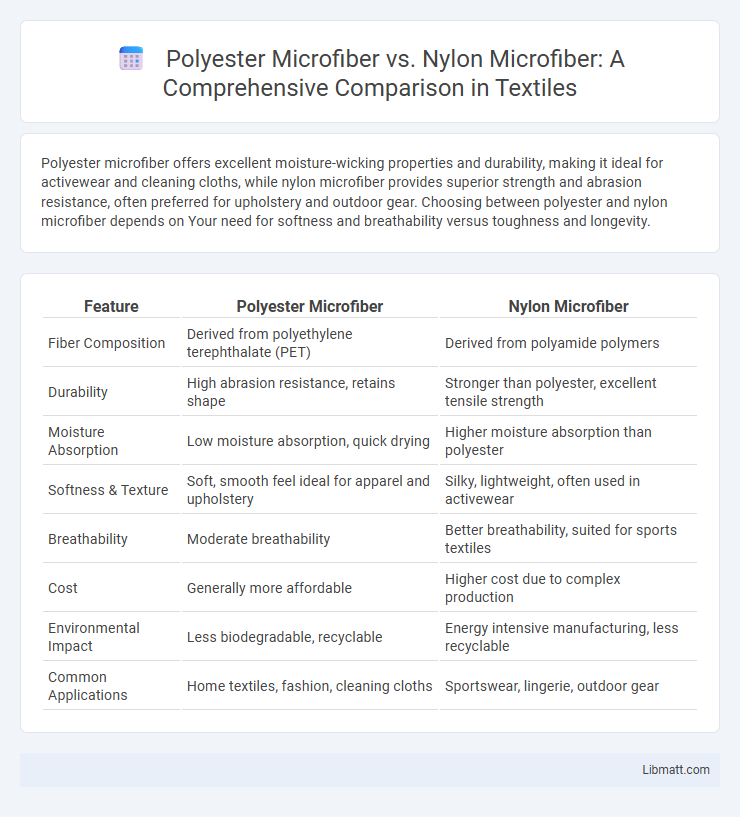Polyester microfiber offers excellent moisture-wicking properties and durability, making it ideal for activewear and cleaning cloths, while nylon microfiber provides superior strength and abrasion resistance, often preferred for upholstery and outdoor gear. Choosing between polyester and nylon microfiber depends on Your need for softness and breathability versus toughness and longevity.
Table of Comparison
| Feature | Polyester Microfiber | Nylon Microfiber |
|---|---|---|
| Fiber Composition | Derived from polyethylene terephthalate (PET) | Derived from polyamide polymers |
| Durability | High abrasion resistance, retains shape | Stronger than polyester, excellent tensile strength |
| Moisture Absorption | Low moisture absorption, quick drying | Higher moisture absorption than polyester |
| Softness & Texture | Soft, smooth feel ideal for apparel and upholstery | Silky, lightweight, often used in activewear |
| Breathability | Moderate breathability | Better breathability, suited for sports textiles |
| Cost | Generally more affordable | Higher cost due to complex production |
| Environmental Impact | Less biodegradable, recyclable | Energy intensive manufacturing, less recyclable |
| Common Applications | Home textiles, fashion, cleaning cloths | Sportswear, lingerie, outdoor gear |
Introduction to Polyester and Nylon Microfibers
Polyester microfiber is composed of fine synthetic fibers derived from polyethylene terephthalate, known for its durability, wrinkle resistance, and moisture-wicking properties. Nylon microfiber, made from polyamide fibers, offers exceptional strength, elasticity, and abrasion resistance, making it ideal for high-performance textiles. Both materials are widely used in apparel and upholstery due to their lightweight nature and ability to retain color vibrancy.
Understanding Microfiber Technology
Microfiber technology involves synthetic fibers finer than one denier, enhancing fabric softness, durability, and moisture-wicking properties. Polyester microfiber excels in water resistance and color retention due to its hydrophobic nature and molecular structure. Nylon microfiber offers superior elasticity and abrasion resistance, benefiting activewear and high-performance textiles.
Composition: Polyester Microfiber Explained
Polyester microfiber consists of extremely fine fibers derived from polyethylene terephthalate (PET), a synthetic polymer known for its durability and moisture resistance. These fibers create a soft yet strong fabric that excels in breathability and quick-drying properties, making it ideal for activewear and cleaning cloths. Your choice between polyester and nylon microfiber should consider polyester's ability to maintain color vibrancy and resist fading over time.
Composition: Nylon Microfiber Detailed
Nylon microfiber is composed of ultra-fine synthetic fibers derived from polyamide polymers, characterized by exceptional strength and elasticity. These fibers have a higher density and smooth surface, enhancing durability and resistance to abrasion compared to polyester microfiber. The molecular structure of nylon allows for superior moisture-wicking properties and a softer texture, making it ideal for performance textiles and cleaning applications.
Durability: Polyester vs Nylon Microfibers
Nylon microfiber offers superior durability compared to polyester microfiber, with higher resistance to abrasion, tearing, and general wear over time. Polyester microfiber tends to be less resilient under heavy use but provides better resistance to UV damage and moisture absorption. Your choice depends on whether longevity or exposure to elements is more critical for your application.
Absorbency and Drying Properties
Polyester microfiber offers excellent absorbency due to its fine fiber structure, enabling it to hold more water compared to nylon microfiber, which tends to repel moisture. Nylon microfiber dries faster than polyester because of its lower water retention, making it ideal for applications where rapid drying is crucial. The combination of high absorbency in polyester and quick-drying capability in nylon makes each suited for specific uses such as cleaning cloths or athletic wear.
Softness and Texture Comparison
Polyester microfiber offers a plush, smooth texture with a slightly brushed finish that enhances softness, making it ideal for cozy bedding and apparel. Nylon microfiber tends to be denser and smoother with a silkier feel, providing durability and a more luxurious touch often preferred in activewear and upholstery. Both materials excel in softness, but polyester microfiber generally delivers a warmer, cushier sensation, while nylon microfiber emphasizes sleekness and tensile strength.
Cleaning Effectiveness and Applications
Polyester microfiber excels in cleaning effectiveness by trapping dirt and moisture efficiently due to its split fibers, making it ideal for household cleaning and polishing delicate surfaces. Nylon microfiber, known for its durability and abrasion resistance, performs well in heavy-duty cleaning tasks and industrial applications where scrubbing power is essential. Your choice between polyester and nylon microfiber should consider the specific cleaning requirements and the surface sensitivity to achieve optimal results.
Environmental Impact and Sustainability
Polyester microfiber typically originates from recycled plastic bottles, contributing to reduced plastic waste but raising concerns about microplastic pollution during washing. Nylon microfiber production demands higher energy use and emits more greenhouse gases but offers greater durability, potentially extending product lifespan and reducing replacement frequency. Both materials pose environmental challenges, with ongoing innovations aimed at improving biodegradability and minimizing microfiber release to enhance sustainability.
Choosing the Best Microfiber for Your Needs
Polyester microfiber offers superior softness and is highly effective at trapping dirt and moisture, making it ideal for cleaning delicate surfaces and absorbing spills. Nylon microfiber provides greater durability and abrasion resistance, suited for heavy-duty scrubbing and long-lasting use. Selecting the best microfiber depends on the specific task, with polyester excelling in gentle cleaning and nylon preferred for tougher, more intensive applications.
Polyester Microfiber vs Nylon Microfiber Infographic

 libmatt.com
libmatt.com